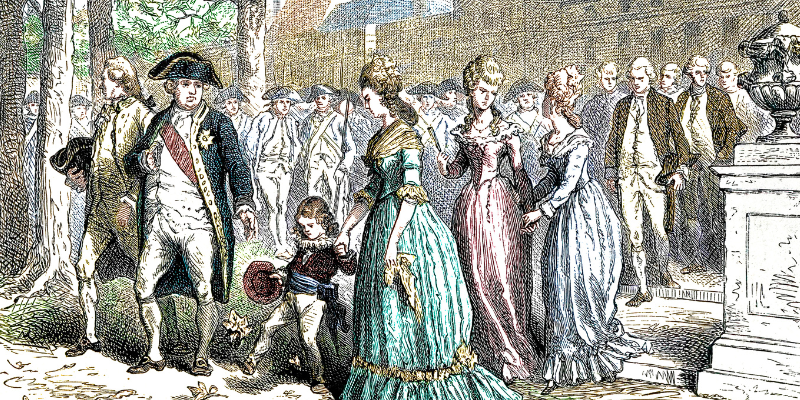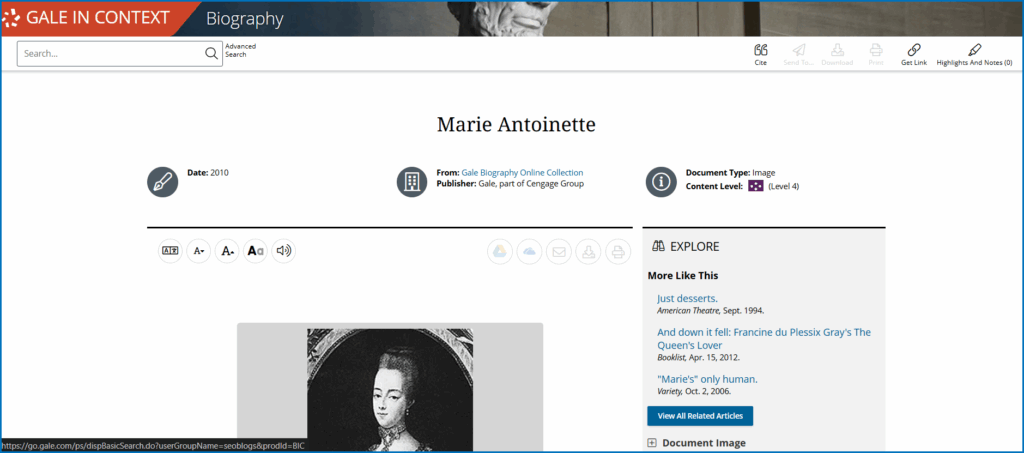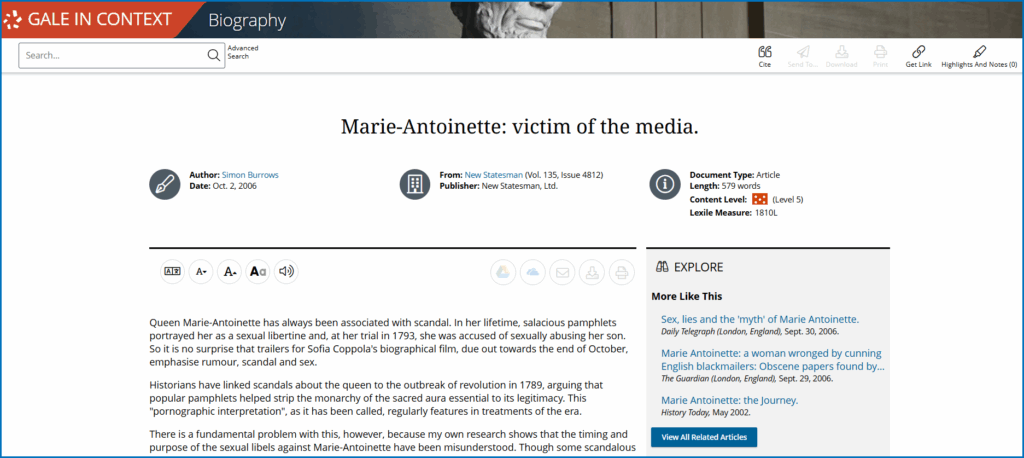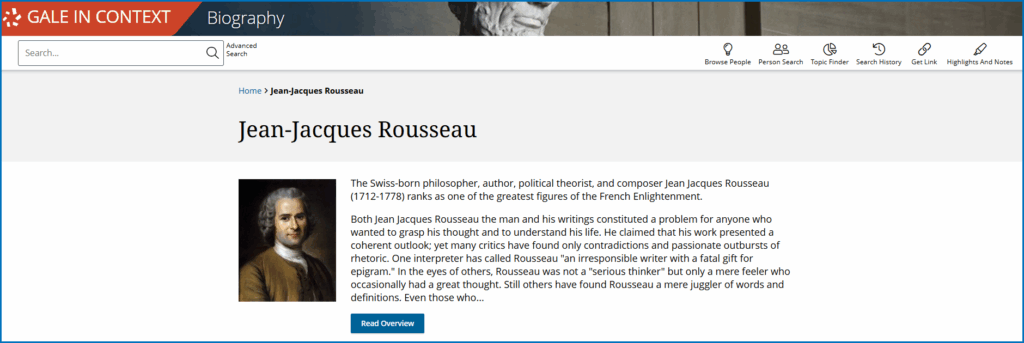|By Gale Staff|
Born in 1755 to Holy Roman Emperor Francis I and Empress Marie-Thérèse, Marie Antoinette rose to the French throne during a critical time in French—and global—history. She left home at 14 for her new life in France, where the people welcomed her warmly. Within two decades, however, public opinion had turned, leading to her execution at age 37.
Few royals have been subject to such scandal and gossip, or managed to sustain public fascination quite like Antoinette. With help from Gale In Context: Biography, invite your high school students to sharpen their research skills to separate fact from fiction by exploring a wealth of articles, biographies, images, and audio files that bring Antoinette’s story to life.
Understand Marie Antoinette’s Background as an Outsider
Maria Antonia Josepha Joanna was born into Austria’s royal family on November 2, 1755. As a child, Marie Antoinette learned arts, classics, history, and religion from a French tutor. She excelled in art but was not as skilled in other subjects. Her parents married for love, a rarity among royalty, and likely an important influence on her own ideas about marriage and parenthood.
Antoinette’s mother built alliances by marrying off her daughters to other European royal families—including, of course, Antoinette herself. On May 16, 1770, 14-year-old Marie Antoinette traveled to France in anticipation of her wedding to the French Dauphin, the future King Louis XVI. The insecure Dauphin was reportedly intimidated by her assertiveness when he and his grandfather, King Louis XV, met her northeast of Paris.
The future king and queen were very different people. Louis was withdrawn, whereas Antoinette exhibited a tendency toward impulsivity. However, there is little, if any, evidence that Antoinette carried on extramarital affairs, as had been rumored at the time. In turn, Louis was faithful and devoted to his wife and children.
Follow the Decline in Antoinette’s Popularity
In the years preceding the French Revolution, the nation sank deeper into debt. Expensive wars and a three-tiered social class structure that benefited the clergy (First Estate) and nobility (Second Estate) contributed to the ongoing economic distress.
The growing wealth inequality left the common people (Third Estate) with little to live on. Commoners bore the brunt of heavy taxation without any political representation, while members of the upper classes paid virtually no taxes at all. Moreover, poor harvests throughout the country resulted in nationwide food shortages.
Being thrust into an unstable political climate put Antoinette at odds with the public, which viewed her and other members of the noble class as symbols of excess and corruption. Cloistered in the comfort of Versailles, the royal couple appeared unconcerned with the country’s economic hardships and the public’s growing discontent. Antoinette’s expenses didn’t help, either: gambling, jewelry, clothes, extravagant Versailles apartments.
Common people weren’t the only ones gossiping about the queen’s excesses. Because of her Austrian roots, nobles at court were skeptical of her loyalty to France. Many of them also had concerns about her possible influence over the king’s policies and views on democratic reform. Political pamphlets circulated nationwide, portraying the queen with cartoonish imagery. The propaganda within those pamphlets accused her of “perverse” and “scandalous” activities while the country was going through financial and political instability.
The so-called Diamond Necklace Affair (1785–86) dealt a significant blow to Antoinette’s reputation. Jeanne de la Motte, a woman impersonating the queen, convinced French clergyman Cardinal de Rohan to steal an extravagant diamond necklace on her behalf to help improve her standing with Louis. When this scheme came to light, the public believed the queen had taken part. In reality, Antoinette knew neither of the necklace nor the plot—but the damage was done.
The Women’s March on Versailles
On the morning of October 5, 1789, angered over the price of bread, women in Paris took to the streets to vent their frustrations. Their demands drew the attention of activists who favored a constitutional monarchy and other political reforms to limit the king’s power. Together, they forcibly entered the city’s armory to obtain weapons and then made their way toward the Palace of Versailles, about 12 miles away, to confront the king. When they reached the palace, the angry crowd broke through the front gates, demanding bread and economic concessions.
The next day, the protesters marched the king and queen back to Paris and forced them and their children into house arrest at the Tuileries Palace.
This marked a turning point in the Revolution, especially with the rise of the National Assembly and its control over royal authority. However, Louis was still determined to regain his authority through secret negotiations, and—with Antoinette’s help—assistance from Austria and other foreign allies.
On June 20, 1791, the royal family disguised themselves as commoners in an attempt to escape for Austria to obtain support for a counterrevolution. Their attempt to flee failed, which only increased the public’s suspicions.
In December 1792, the National Convention commenced Louis’s trial, accusing the king of “having plotted and formed a multitude of conspiracies to establish tyranny in destroying liberty.” On January 20, the Assembly voted overwhelmingly to find him guilty, and carried out his execution the next day. That same year, a revolutionary tribunal put Antoinette on trial and found her guilty of aiding the enemy and inciting civil war. She was sentenced to death and executed by guillotine on October 16, 1793.
Debate Antoinette’s Sensitivity Toward the Public’s Suffering
Scholars continue to debate Antoinette’s role in the demise of the French monarchy. Despite being portrayed as indifferent to the suffering of the common people, anecdotes have surfaced of her compassion for those less fortunate, particularly the children she adopted.
One such child was three-year-old Jacques Gagné, who was playing near the palace grounds in Versailles when the queen’s carriage almost ran him over. After asking the grandmother’s permission to adopt him, the queen changed the child’s name to Armand de Bourbon. Even after she had her own children, she continued to oversee his education and financially support him.
Another adopted child was an enslaved boy whom a family friend presented to Antoinette as a “gift.” Instead, the queen granted the boy his freedom, adopted him, and named him Jean Amilcar. She saw to his education and sent him to Liancourt College, where he could train as a painter.
Even when the Revolution was in full swing, Antoinette adopted three orphaned girls. She sent two to a convent to be educated in safety and kept the youngest one to live with her at the Tuileries.
Critical Thinking Questions
- If the public were more aware of Antoinette’s charitable causes, including the children she adopted, would it have made a difference in their views toward her? Why or why not?
- To what extent can Antoinette be seen as both a victim of her circumstances and an active participant in her own downfall? Can you think of modern leaders who found themselves trapped in similar circumstances?
Dispel the Myths Behind Antoinette
Curiosity about Antoinette has given rise to enduring myths and misconceptions. Perhaps the most famous inaccuracy about the queen is her allegedly saying, “Let them eat cake,” in response to citizens being unable to afford bread. There is no evidence to suggest that she spoke such words.
Several versions of this phrase have been attributed to the royal family, including two of King Louis’ aunts. In 1766, Jean-Jacques Rousseau wrote “Qu’ils mangent de la brioche” (let them eat brioche) in Confessions, attributing the phrase to “a great princess,” which was probably Marie-Thérèse, Antoinette’s mother. This phrase has been emblematic of aristocratic indifference to the poor and falsely linked to Antoinette in anti-monarchical propaganda.
More broadly, popular mythology from the era exaggerated her influence on national politics leading up to the Revolution. Historical accounts strongly suggest that the queen was more interested in alleviating her boredom and performing charitable works than in influencing domestic policies.
Critical Thinking Questions
- If Antoinette were alive today, how might people use social media platforms like TikTok or Instagram to portray her? How could Antoinette have used these platforms to her own advantage?
- Why has the mythology around Antoinette persisted over the centuries? What can it teach us about rumors and propaganda?
Antoinette’s Enduring Influence on Contemporary Culture
Antoinette continues to fascinate historians and the general public alike. Her legend and larger-than-life image endure in our imaginations through contemporary films and fashion.
Cinema
Many movies have captured Antoinette’s life and mystique. The biopic Marie Antoinette (2006), starring Kirsten Dunst and Jason Schwartzman, focused on the queen’s early years at Versailles. With its emphasis on her youth, the film portrayed the queen in human terms, especially in her struggles with isolation and adjustment to a new life away from Austria. Director Sophia Coppola’s approach blended historical aspects of the story with modern music, visuals, and props. One example was a scene giving a brief glimpse of Converse sneakers amid Antoinette’s extensive show collection, accompanied by the song “I Want Candy.”
The 2024 film The Flood took a different approach. Starring Mélanie Laurent as Marie Antoinette and Guillaume Canet as Louis XVI, the movie examines the queen’s final days during the French Revolution. This movie is a sobering departure from other biopics that often portray the glamour of royal life. Instead, The Flood invites audiences to dwell on the fear and uncertainty that the king and queen experienced as their world came crashing down around them.
Critical Thinking Questions
- In general, compared to historical accounts, how do dramatized versions of history (such as films) shape our opinions of figures like Marie Antoinette?
- Why do filmmakers continue to retell the story of the Revolution and Antoinette? What new insights might they offer?
- How did Coppola’s directorial style help audiences see the queen as more relatable?
Fashion and Popular Culture
Could Marie Antoinette be the first modern fashion icon? Today, drag queens and pop singers like Madonna still incorporate elements such as powdered wigs, corsets, and crinolines into their performances and attire. Over the years, many fashion designers have also paid homage to Antoinette through their creations. Famous labels, such as Moschino and Jeremy Scott, have incorporated her 18th-century abundance into several modern styles. Elaborate touches, such as frills and pastels, are often attributed to Antoinette.
Critical Thinking Questions
- Why might pop singers and other performers choose to incorporate 18th-century fashion elements into their performances?
- What might Antoinette-inspired fashion and style suggest about how society views the events of her time?
Engage Your Students with Learning Activities
Assign students to write fictional diary entries from the perspective of Antoinette or other figures living during the French Revolution. What was their experience like? Was it something that stirred hope of a better future—or did the changes on the horizon worry them? Ask students to share and discuss their entries with classmates.
Need some inspiration? Your students can turn to the personal accounts of the queen, including her letters to her close friend, Count Axel von Fersen. You might also read Ribbons of Scarlet, a collection of stories about real women’s experiences of the French Revolution.
Looking for more activity ideas? Check out the Gale Support portal.
Partner with Gale to Enhance Student Learning
Marie Antoinette’s life provides a rich opportunity for students to comprehend nuanced historical topics from multiple perspectives. With our suite of trustworthy, vetted resources, Gale In Context: Biography can help you enhance student learning in memorable ways.
For more information about Gale’s resources and services, contact your local representative today.





